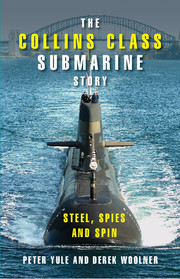Book contents
- Frontmatter
- Contents
- List of key people
- List of acronyms
- Introduction
- Part 1 You Can't Build Submarines in Australia
- 1 ‘The one class of vessel that it is impossible to build in Australia’: Australia's early submarines
- 2 Australia's Oberon class submarines
- 3 The submarine weapons update program and the origins of the new submarine project
- 4 The new submarine project
- 5 ‘We can't build submarines, go away’: Eglo Engineering and the submarine project
- 6 The acts of the apostles
- 7 ‘But how will you judge them?’: the tender evaluation process 1984–85
- 8 Spies, leaks and sackings: from tender evaluation to project definition study
- 9 The project definition study 1985–86
- 10 Debating the laws of physics: picking winners 1987
- Part 2 The Honeymoon Years 1987–92
- Part 3 ‘A Strange Sense of Unease” 1993–98
- Part 4 Resolution
- Notes
- Index
9 - The project definition study 1985–86
Published online by Cambridge University Press: 05 September 2013
- Frontmatter
- Contents
- List of key people
- List of acronyms
- Introduction
- Part 1 You Can't Build Submarines in Australia
- 1 ‘The one class of vessel that it is impossible to build in Australia’: Australia's early submarines
- 2 Australia's Oberon class submarines
- 3 The submarine weapons update program and the origins of the new submarine project
- 4 The new submarine project
- 5 ‘We can't build submarines, go away’: Eglo Engineering and the submarine project
- 6 The acts of the apostles
- 7 ‘But how will you judge them?’: the tender evaluation process 1984–85
- 8 Spies, leaks and sackings: from tender evaluation to project definition study
- 9 The project definition study 1985–86
- 10 Debating the laws of physics: picking winners 1987
- Part 2 The Honeymoon Years 1987–92
- Part 3 ‘A Strange Sense of Unease” 1993–98
- Part 4 Resolution
- Notes
- Index
Summary
Looking back on his lengthy involvement with the new submarine project, Oscar Hughes reflects:
I think that the Government decisions in late May 1985 that led into the PDS [project definition studies] were significant and far reaching. Firstly, the Government accepted (albeit implicitly) the departure from the earlier strategy of basing the design of the new submarine on an ‘existing design’ and secondly, agreed that all submarines would be built in Australia. In my view these decisions sent a very clear message to both the German and the Swedish companies as well as Australian industry that the Navy was utterly serious in developing a new submarine for the mid-1990s and beyond….The efforts of Graham White, John White, John Halfpenny and many others with Australian industry involvement had really paid off and also importantly it would not be a ‘build to print’ exercise…but one that offered the prospect of innovation, development, new design, new technology and the opportunity for Australian industry to work with overseas companies who were world leaders in their field. A great deal of the credit goes to Kim Beazley.
With Oscar Hughes in charge of the project office and the consortia in place, the new submarine project entered one of its most crucial and controversial periods. Most people with a background understanding of submarine design and development expected that IKL/HDW would be one of the participants in the project definition study; the inclusion of Kockums was startling. The promising but untested German design was not without risks and prudence might have suggested a more predictable counterbalance. The British and Dutch camps expected their more mature designs would put them in this role.
- Type
- Chapter
- Information
- The Collins Class Submarine StorySteel, Spies and Spin, pp. 89 - 100Publisher: Cambridge University PressPrint publication year: 2008



